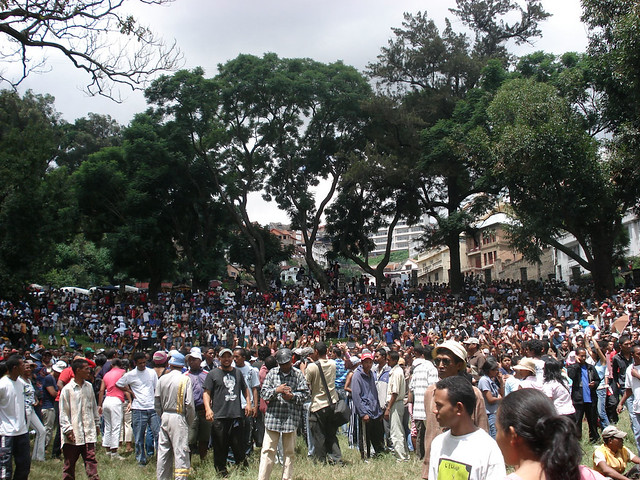
Isolated for around 80 million years, the island of Madagascar is home to hundreds of animals and plants that exist nowhere else in the world. A biodiversity hotspot of exotic fauna and flora, the Indian Ocean island is often likened to paradise. Yet Madagascar continues to be rocked severe economic and political crises – problems that remain largely unnoticed by Western audiences.
Ever since the 2009 ouster of its democratically elected president Marc Ravalomanana, Madagascar has been paralyzed by a political stalemate that has brought the already impoverished island of 20 million people to the brink of economic collapse. Although progress made in recent reconciliation talks has led to Western donors to gradually resume development aid, the road back to democracy promises to be a rocky one.
The political upheavals began after dissident army officers took power in what was regarded by the international community as a coup d’état. Officially, President Ravalomanana stepped down following violent street protests led by opposition leader Andry Rajoelina – a self-made dairy tycoon – and handed power to the military which in turn transferred its authority to Rajoelina. This prompted Rajoelina to declare himself as president of the “High Transitional Authority” (HAT) and consolidate a tight grip on the country’s politics. Ravalomanana, by contrast, fled into self-imposed exile in South Africa and was prevented twice from returning to Madagascar where he was sentenced in absentia to life imprisonment for allegedly ordering the killing of protestors.
Since then, South Africa and the Seychelles have acted as mediators in negotiations aimed at lifting the country out of its crisis. In 2011 an agreement brokered by the Southern African Development Community (SADC) was signed by Madagascar’s major political parties laying out a roadmap for the country’s return to democracy. Amnesty provisions were discussed, elections were scheduled and Ravalomanana prepared to return to the island.
However tensions have recently flared up again after a mutiny by soldiers at a base just outside Madagascar’s capital, Antananarivo, left three dead and dozens wounded. The mutiny, which was eventually put down by the military, occurred in the run-up to the much-awaited talks between the ousted president and Madagascar’s transitional leader. Although the negotiations did not yield the desired results, Ravalomanana and Rajoelina agreed to meet again and a progress report is due to be presented to the SADC.
Yet with the political instability slowing economic growth in a country that is already grappling with high poverty rates, it is high-time for things to move forward. Madagascar is one of the poorest countries in the world, ranked only 151st out of 187 countries by the United Nations’ Human Development Index. According to the UN World Food Program, over 75% the country’s 20 million inhabitants live below the poverty line. The Economist Intelligence Unit further estimates that, since Rajoelina has been in power, the Malagasy economy has seen growth in Gross Domestic Product (GDP) decline from 7% in 2008 to an estimated 0.7% by 2011.
Besides the country’s badly hit tourism industry – which Antananarivo depends on for most of its revenue – investors interested in Madagascar’s gold, oil and chrome reserves have also been reigning in their enthusiasm as a result of the political uncertainty. Chronic food insecurity, unemployment, corruption and criminality further add to the precarious situation of the country.
Heavily reliant on foreign aid – a report by the US Congressional Research Service indicates that foreign development assistance accounted for 40% of Madagascar’s budget and 75% of investments in public spending – the island was also heavily affected by cuts in international development assistance following the coup d’état. In the aftermath of Ravalomanana’s transfer of power, the US cut its development aid, closely followed by the European Union (EU) which suspended all assistance a year later. Besides cuts in development assistance, sanctions were imposed on the new regime, including the removal of trade benefits, suspension of membership of transnational organizations like the African Union and personal sanctions on individuals.
With the implementation of most of the provisions put forth in the roadmap going relatively smoothly, the EU decided on August 8 to resume development assistance – an encouraging sign amidst the political turmoil and economic crisis. Despite these positive developments, however, several unknowns still remain. Will self-declared president Rajoelina indeed allow Ravalomanana back into Madagascar? Will elections scheduled for next year be free and fair? Will the HAT allow a peaceful transfer of power? And will the drafting of a new constitution lead to a more stable country?
With many issues still unresolved and new conflicts looming on the horizon, it will likely be a long haul back to stability, security – and paradise – for Madagascar.
For further information on the topic, please view the following publications from our partners:
Madagascar : Sortir du cycle de crises
UN Mediation and the Politics of Transition after Constitutional Crises
Unconstitutional Changes of Government in Africa: What Implications for Democratic Consolidation?
For more information on issues and events that shape our world please visit the ISN’s Security Watch and Editorial Plan.

